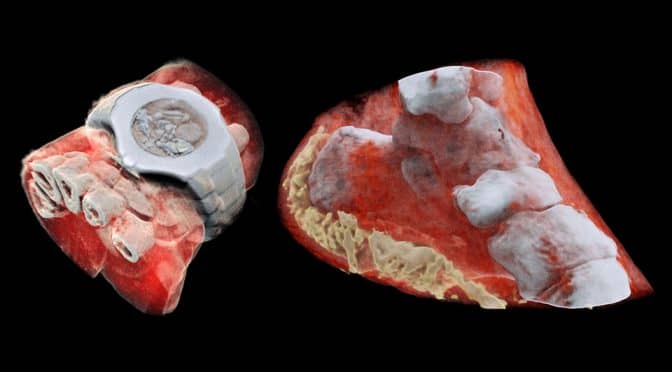MARS Bioimaging, which was created after 10 years of work, recently revealed its first x-ray scans. The scanner was designed by Phil and Anthony Butler who are related to each other as father and son. Phil is a physics professor, and Anthony is a bioengineering professor. Both of them worked together to create MARS and put foundations of a family business. The scanner this duo formed is an x-ray machine. However, it is not like an ordinary x-ray machine.


To get an overview, let’s recall how x-ray machines work to get an image. X-rays thrown on a body gets absorbed by the bones and pass through the rest of the body. The bones appear in white on the film while everything else around them is displayed in black. Now the scanner developed by the Butler’s uses a combination of Medipix technology. This tech was developed by researchers to help at the European Organization for Nuclear Research (CERN). It tracks particles using the Large Hadron Collider and computer algorithms to produce colored 3D x-ray.


The results obtained are not in the form of a plain 2D figure. The scanner records the energy levels of the x-rays when they hit each particle of the body. It translates the measurements into various colors and represents the bones, muscles, and other body tissues as well. The x-rays used currently are enough for doctors to notice any fracture in the bones, but they give very less information about the surrounding tissues and the muscles. Using the 3D x-rays, doctors will be able to diagnose issues in the bones as well as in the surrounding areas as well. Phil Butler said, “This technology sets the machine apart diagnostically because its small pixels and accurate energy resolution mean that this new imaging tool is able to get images that no other imaging tool can achieve.”


The MARS scanner is already in use for some studies including some which are focusing entirely on cancer and strokes. Anthony said in an interview, “In all of these studies, promising early results suggest that when spectral imaging is routinely used in clinics, it will enable more accurate diagnosis and personalization of treatment.” The researchers further plan to test their scanner in a trial which focuses on orthopedic and rheumatology patients in New Zealand. If the trials are successful, it will still take years before the device gets approval from regulatory authority and be used everywhere, replacing the traditional method of x-rays.


